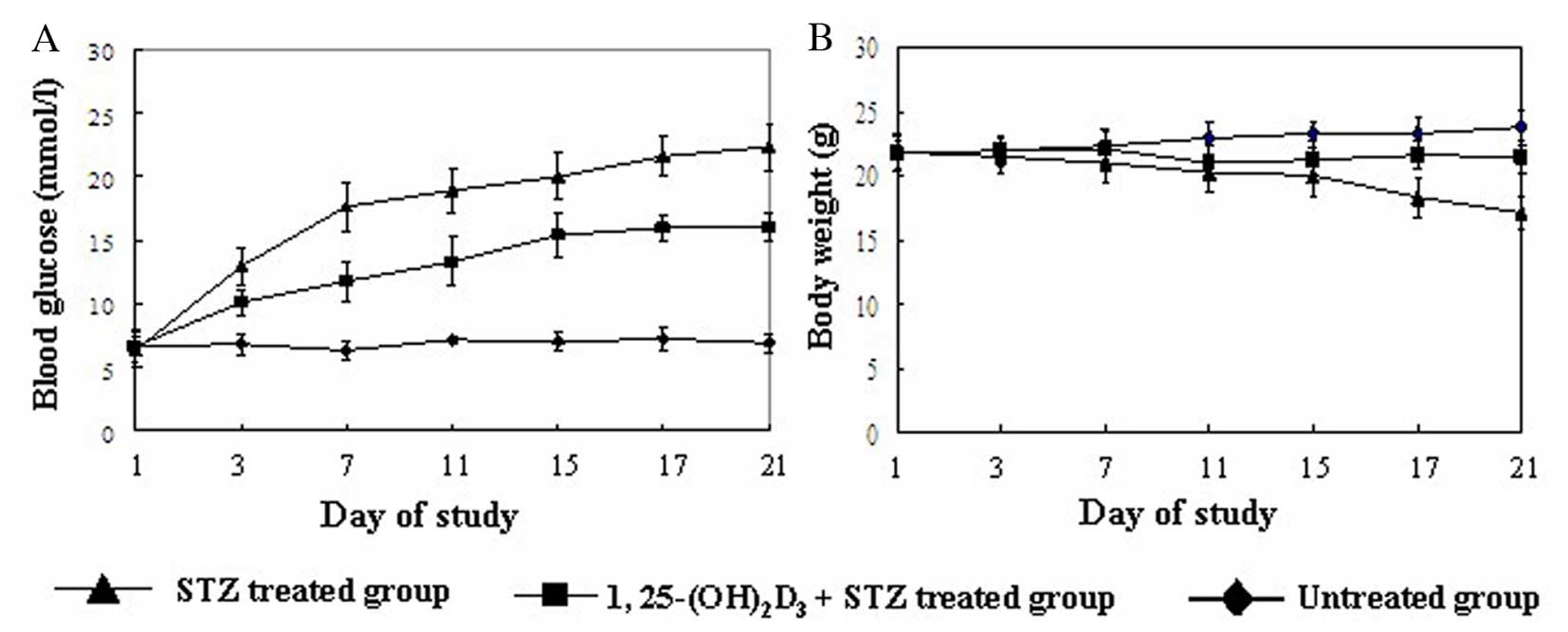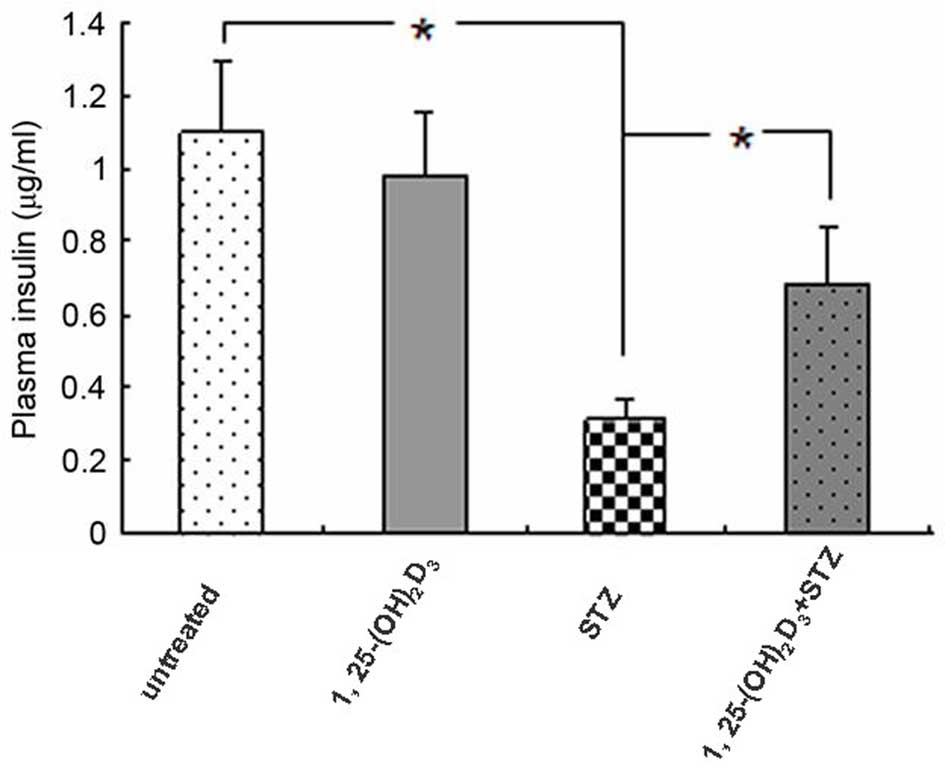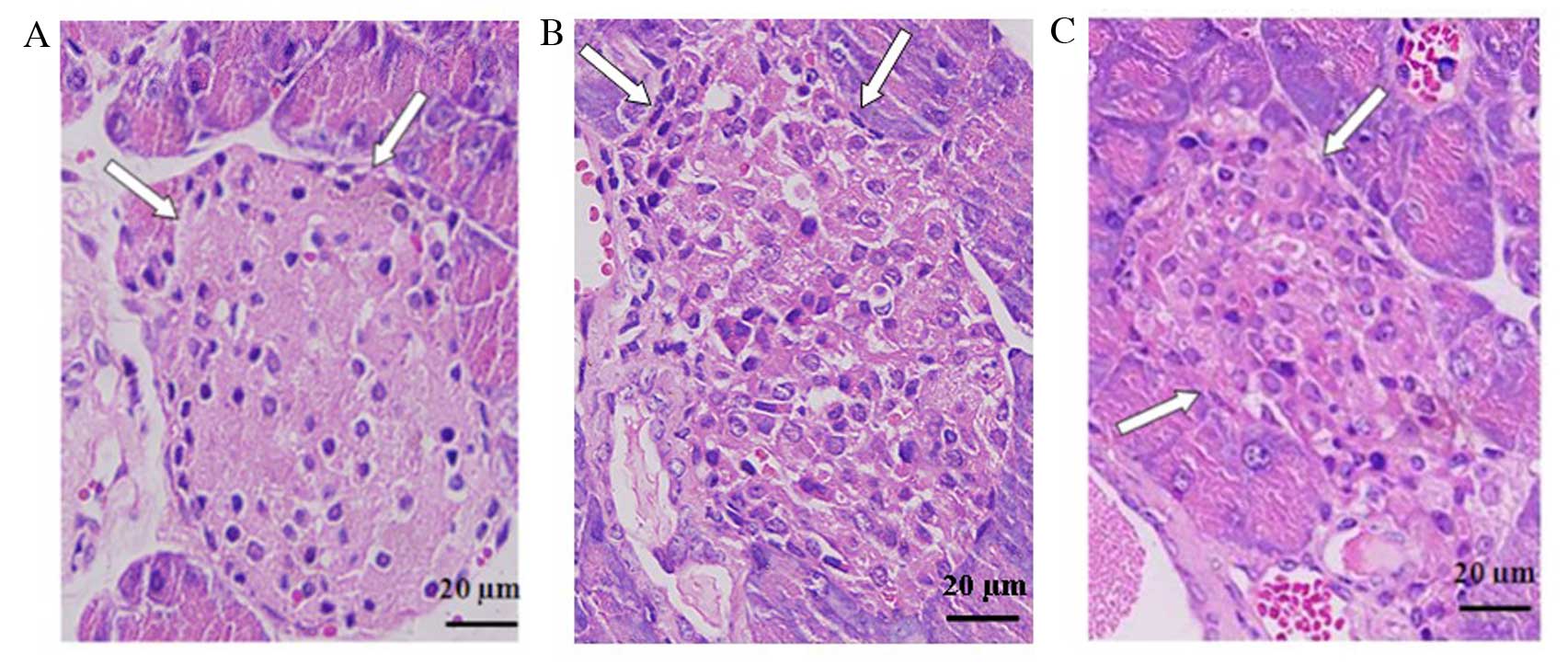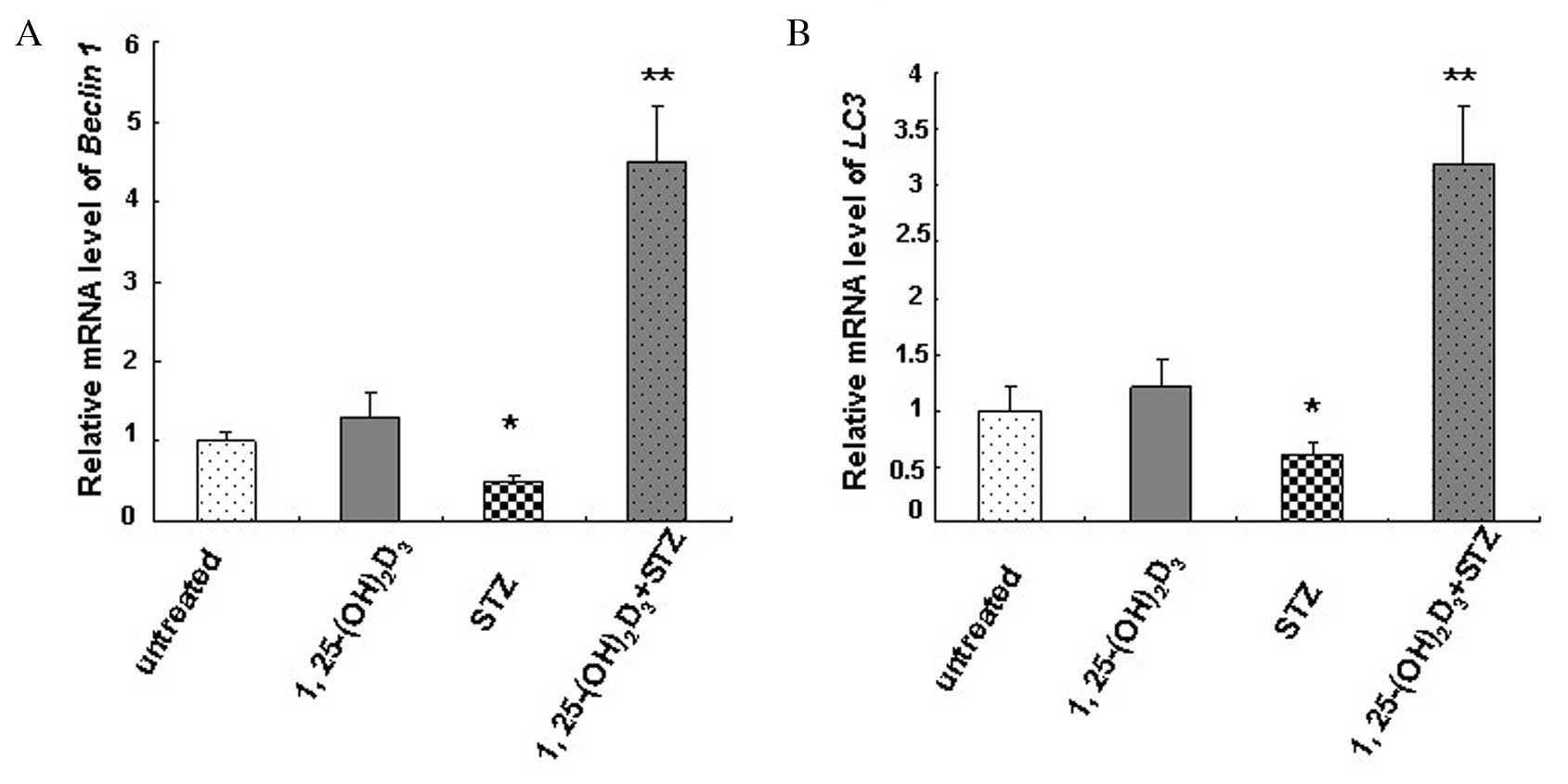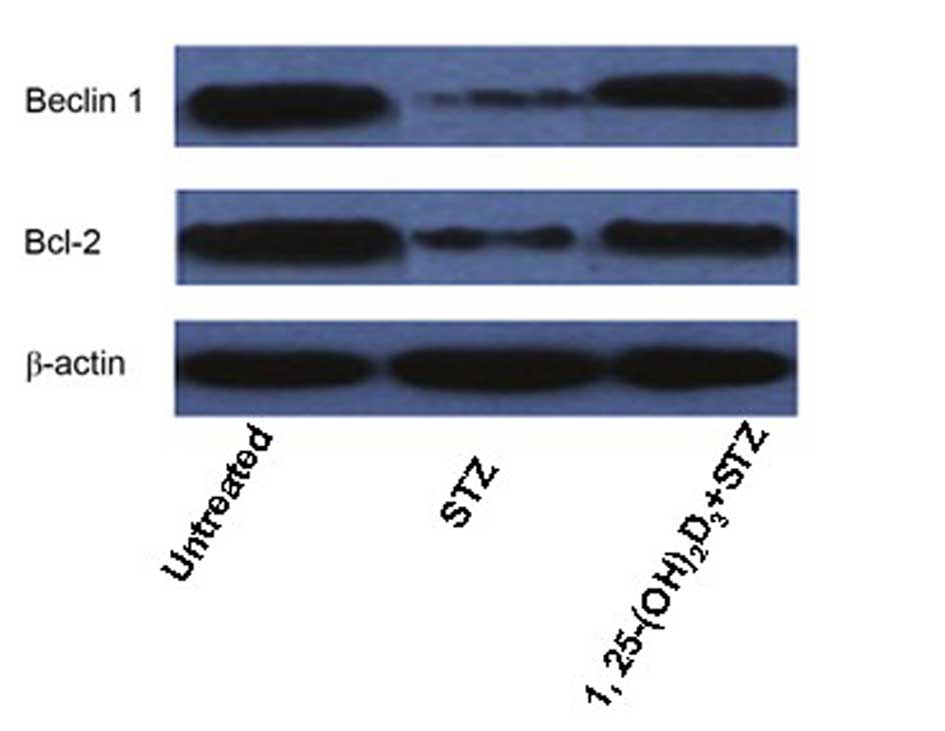Vitamin D induces autophagy of pancreatic β-cells and enhances insulin secretion
- Authors:
- Published online on: July 19, 2016 https://doi.org/10.3892/mmr.2016.5531
- Pages: 2644-2650
Abstract
Introduction
Diabetes mellitus is a worldwide health problem, with global incidence estimated at >380 million cases and rising (1). The International Diabetes Federation estimates that by 2035, 592 million people will suffer from diabetes (1). Among diabetic patients, ~10% suffer from type 1 diabetes mellitus (T1DM). T1DM, which primarily affects younger people, results in lifelong dependency on exogenous insulin treatment for survival and has the potential for serious complications, including cardiovascular disease, chronic renal failure and eye damage (2). Although the etiology and pathogenesis of T1DM remain to be fully elucidated, there is a consensus that the autoimmune destruction of insulin-producing pancreatic islet β-cells, as a result of environmental and genetic factors, is critical for its development (3).
Vitamin D has been well-characterized as a regulator of calcium-phosphorus metabolism and bone mineralization (4). While vitamin D exerts other biological effects, its extra-skeletal activities have been extensively investigated. Numerous epidemiological studies have suggested that vitamin D may have a role in defense against diabetes (5,6). Vitamin D deficiency is prevalent among the diabetic population; early and long-term vitamin D supplementation is associated with a decrease in the risk of developing diabetes, and the incidence of T1DM is greater in areas with fewer days of sunlight per year (7,8). However, the underlying mechanisms of the involvement of vitamin D in T1DM remain to be elucidated. The present study aimed to investigate the role of vitamin D in the development of diabetes and the underlying mechanisms.
Autophagy ('self-eating') is a catabolic process of the lysosomal degradation pathway that enables metabolic turnover and homeostasis (9). It is characterized by the sequestration of cytoplasm and organelles to form autophagosomes, which fuse with lysosomes to form autophagolysosomes, resulting in the proteolysis of sequestered material (10). It has been reported that autophagy may influence diverse physiological processes and affect the occurrence and outcome of numerous diseases, including diabetes (11,12). Previous studies have revealed that baseline autophagy is crucial for the maintenance of the normal architecture of pancreatic islets and intracellular insulin content (13,14). In the present study, the role of vitamin D in the pathogenesis of diabetes was investigated, in particular the direct effects of vitamin D on pancreatic β-cells. The results revealed, for the first time to the best of our knowledge, that vitamin D enhances autophagy while inhibiting apoptosis of streptozotocin (STZ)-treated β-cells, increases insulin secretion and increases resistance of β-cells to cellular stress encountered during diabetes.
Materials and methods
Animals and experimental protocol
A total of 40 C57BL/6J male mice (age, 10 weeks) were provided by Shanghai Laboratory Animal Center, Chinese Academy of Sciences (Shanghai, China). All mice were maintained at 23±2°C in 50±5% relative humidity under a 12-h light/dark cycle, and had free access to food and water. The T1DM mouse model was induced by multiple intraperitoneal injections of low-dose STZ (Sigma-Aldrich, St. Louis, MO, USA) as described previously (15). Briefly, the experimental mice received intraperitoneal injections of freshly prepared 40 mg/kg STZ [dissolved in 0.1 M citrate buffer (Sigma-Aldrich)] for 5 consecutive days. The first day of STZ administration was designated as day 1 of the study. Body weight, food and water intake, and plasma glucose were monitored weekly for 21 days. Blood was collected from the tip of the murine tail vein, and non-fasting blood glucose concentrations were measured by the glucose oxidase method as described previously (16). Mice were considered diabetic when their glucose levels were >16.7 mmol/l. To investigate the effect of vitamin D on the course of the STZ-induced T1DM mouse model, 1,25(OH)2D3 (Sigma-Aldrich), the physiologically active metabolite of vitamin D, was administered intraperitoneally 1 h prior to STZ injection at a dose of 5 µg/kg (dissolved in peanut oil), and every second day until sacrifice. Mice in the control group were left untreated. Mice were sacrificed by cervical dislocation on day 21; pancreases were removed for histological examination and plasma separated from blood by centrifugation at 1,500 × g, 4°C for 10 min was stored at −80°C for the insulin assay. The protocol for the present study was in accordance with the Principles of Laboratory Animal Care and approved by the Administration Committee of Laboratory Animals of Soochow University (Suzhou, China).
Histopathological analysis of pancreatic islets
The pancreases were dissected out, fixed in 10% formalin for 2 h and embedded in paraffin. Sections (5–10 µm) were stained with hematoxylin and eosin as previously described (17). Histopathological evaluation was performed in a blinded fashion. The severity of insulitis was determined by the extent of cellular infiltration and the presence of islet atrophy was analyzed under light microscopy (magnification, ×400).
Cell culture and analysis of insulin secretion
MIN6 mouse insulinoma β-cells (Shanghai Bioleaf Biotech Co., Ltd., Shanghai, China) were maintained in Dulbecco's modified Eagle's medium (DMEM) (Sigma-Aldrich) supplemented with 15% fetal bovine serum (Sigma-Aldrich), 50 mg/l streptomycin and 75 mg/l penicillin at 37°C in an incubator containing 5% CO2. Preliminary experiments revealed that treatment with 5 mM STZ for 30 min resulted in significant destruction of MIN6 cells. To evaluate the direct effect of vitamin D on pancreatic β-cells, MIN6 cells were treated with 0.01 nM 1,25(OH)2D3 in DMEM for 24 h prior to STZ administration. Control untreated MIN6 cells, MIN6 cells treated with 5 mM STZ for 30 min, and MIN6 cells treated with 1,25(OH)2D3 prior to STZ treatment were collected and incubated in low (2.8 mM) or high (20 mM) glucose concentrations for 1 h. Insulin secretion was subsequently measured using an enzyme-linked immunosorbent assay (ELISA) kit (BioExpress; VWR International, Radnor, PA, USA) according to the manufacturer's instructions.
Reverse transcription-quantitative polymerase chain reaction (RT-qPCR)
To evaluate the mRNA expression levels of the autophagy markers, Beclin 1 and microtubule-associated protein 1A/1B-light chain 3 (LC3) in MIN6 cells, RT-qPCR was performed as previously described (18). Total RNA was extracted from MIN6 cells using TRIzol® reagent (Invitrogen; Thermo Fisher Scientific, Inc., Waltham, MA, USA), and cDNA was synthesized with the RevertAid™ First Strand cDNA Synthesis kit (Thermo Fisher Scientific, Inc.), according to the manufacturer's instructions. The mRNA expression levels of Beclin 1 and LC3 were measured using the Platinum SYBR Green qPCR SuperMix-UDG 92 (Invitrogen; Thermo Fisher Scientific, Inc.) and an ABI7500 Real-Time system (Applied Biosystems; Thermo Fisher Scientific, Inc.). A total of 40 cycles were performed, under the following conditions: denaturation at 95°C for 30 sec, annealing at 60°C for 34 sec and extension at 72°C for 30 sec. The primer sequences are listed in Table I. Each reaction was repeated three times and the mRNA expression levels of Beclin 1 and LC3 were normalized to GADPH quantification cycle (Cq) values using the comparative quantification cycle 2−ΔΔCq method (19).
Western blotting
To determine the protein expression levels of Beclin 1 and B-cell lymphoma 2 (Bcl-2), markers of autophagy and apoptosis regulation, respectively, cells were treated with lysis solution (Promega Corporation, Madison, WI, USA), sonicated and centrifuged at 8,000 × g, 4°C for 10 min. The supernatant was collected and protein concentration determined using a bicinchoninic acid assay (Pierce; Thermo Fisher Scientific, Inc.), according to the manufacturer's instructions. Proteins (45 µg) were loaded onto 10% SDS-PAGE gels, subjected to electrophoresis (120 V for 65 min) and transferred onto polyvinylidene difluoride membranes. Following blocking in 5% non-fat milk for 1 h at room temperature, membranes were probed with mouse anti-β-actin antibody (1:5,000; catalog no. AM1021B), rabbit anti-Bcl-2 antibody (1:600; catalog no. AP1303A) or rabbit anti-Beclin 1 antibody (1:500; catalog no. AP1818b) at 4°C overnight. Subsequently, the membrane was incubated at room temperature for a further 2 h, washed in Tris-buffered saline with Tween 20 three times and treated with horseradish peroxidase-conjugated goat anti-mouse IgG (1:5,000; catalog no. ASS1021) or goat anti-rabbit IgG (1:5,000; catalog no. ASR1038) at room temperature for 90 min. All antibodies were obtained from Abgent, Inc., San Diego, CA, USA. Protein bands were visualized with the Enhanced Chemiluminescence Plus Western Blotting Detection system (GE Healthcare Bio-Sciences, Pittsburgh, PA, USA). The protein expression levels of Beclin 1 and Bcl-2 were normalized to β-actin.
Apoptosis assay
Annexin V-Fluorescein Isothiocyanate Apoptosis Detection Kit I (BD Biosciences, Franklin Lakes, NJ, USA) was used for assessment of apoptosis. According to the manufacturer's instructions, three groups of MIN6 cells were pelleted by centrifugation at 600 × g for 5 min at room temperature, washed once with ice-cold phosphate-buffered saline and resuspended in binding buffer. Cell suspensions were then incubated with annexin V and propidium iodide at 25°C for 5–15 min in the dark. Analysis was performed using a flow cytometer (FC500; Beckman Coulter, Brea, CA, USA) and Kaluza software version 1.2 (Beckman Coulter).
Statistical analysis
Data are expressed as the mean ± standard deviation from at least three experiments. Statistical analyses were performed in SPSS version 17.0 (SPSS, Inc., Chicago, IL, USA). Comparisons between groups were conducted using one-way analyses of variance and chi-square tests, followed by Tukey's post hoc test. P<0.05 was considered to indicate a statistically significant difference.
Results
Vitamin D reduces the incidence of T1DM and increases insulin secretion in the mouse model
To investigate the role of vitamin D in diabetes, its effect on the incidence of diabetes and mouse phenotypes was investigated. Treatment with 1,25(OH)2D3 markedly improved diabetes in mice, suggested by gradually decreased blood glucose and increased body weight (Fig. 1). Mice presented with progressive hyperglycemia following STZ treatment, and by 1 week following the initial injection of STZ their plasma glucose levels were all >16.7 mmol/l and diabetes was therefore defined. Administration of 1,25(OH)2D3 significantly reduced the incidence of diabetes (Table II). To evaluate pancreatic β-cell function with regard to insulin secretion, mouse plasma insulin levels were measured on day 21. As presented in Fig. 2, plasma insulin levels were significantly decreased in STZ-treated mice, and 1,25(OH)2D3 inhibited the STZ-induced insulin reduction (P=0.033), suggesting a possible protective effect against β-cell damage. Administration of 1,25(OH)2D3 alone had no effect on insulin secretion compared with the untreated control group.
Table IIEffect of vitamin D on the incidence of STZ-induced diabetes in mice on specific days following the initiation of STZ treatment. |
Vitamin D relieves insulitis of diabetic mice
Histological analysis of the pancreas of STZ-induced diabetic mice revealed cellular infiltration in and around islets, distorted islets and β-cell degeneration. In accordance with the declined incidence of diabetes, the administration of 1,25(OH)2D3 prior to STZ treatment markedly reduced the infiltration of inflammatory cells and other histopathological changes in pancreatic islets (Fig. 3). These results indicate that vitamin D ameliorated islet lesions and β-cell destruction.
Vitamin D enhances insulin secretion of STZ-treated MIN6 cells
To further investigate the in vivo data, the effect of vitamin D on insulin secretion by MIN6 pancreatic β-cell lines was assessed in vitro. Insulin secretion was significantly decreased in STZ-treated MIN6 cells compared with the untreated control group, and 1,25(OH)2D3 enhanced insulin secretion of STZ-treated cells in conditions of low and high glucose concentrations (Table III).
Vitamin D induces the expression of Beclin 1, LC3 and Bcl-2
Relative mRNA expression levels of Beclin 1 (Fig. 4A) and LC3 (Fig. 4B) in MIN6 cells were determined by RT-qPCR. The mRNA content of untreated MIN6 cells was designated as 1.0. The results revealed a significant decrease in Beclin 1 (0.5±0.08; P=0.032) and LC3 (0.6±0.1; P=0.047) mRNA expression levels in the STZ-treated group compared with the untreated control group, while 1,25(OH)2D3 significantly increased mRNA expression levels of Beclin 1 (4.5±0.7; P=0.009) and LC3 (3.2±0.5; P=0.007). 1,25(OH)2D3 treatment alone slightly increased Beclin 1 and LC3 mRNA expression levels compared with the untreated control group (Fig. 4). The results indicate an autophagy deficiency in cells following STZ treatment and induction of autophagy activity by vitamin D.
Western blotting revealed that the protein expression levels of the autophagy and regulation of apoptosis markers, Beclin 1 and Bcl-2, respectively, were markedly downregulated in STZ-treated MIN6 cells compared with untreated cells. This effect was attenuated by treatment with 1,25(OH)2D3 (Fig. 5).
Vitamin D inhibits apoptosis of STZ-treated MIN6 cells
As presented in Table IV and Fig. 6, and consistent with the western blotting results, apoptosis of STZ-treated MIN6 cells was markedly increased, and intervention with 1,25(OH)2D3 decreased the apoptosis rate significantly.
Discussion
T1DM is a global disease of increasing incidence; however, preventive measures and causal treatments remain lacking. It is widely accepted that genetic predisposition and environmental factors contribute to the development of diabetes. Despite the evidence that vitamin D deficiency is one of the environmental risk factors linked to the development of T1DM (20–23), the precise underlying mechanisms remain to be fully elucidated. The present study used a well-established T1DM animal model of STZ-induced diabetes and the insulinoma cell line, MIN6 to investigate the potential involvement of vitamin D in the pathogenesis of diabetes, with an emphasis on its direct effects on pancreatic islet β-cells.
During T1DM development, β-cell injury is induced by infiltrating immune cells, leading to a progressive impairment of insulin production and ultimately resulting in apoptosis (24). In the present study, insulin secretion by STZ-treated β-cells was decreased and pre-treatment with 1,25(OH)2D3 promoted insulin secretion. STZ-treated mice exhibited cellular infiltration in pancreatic islets and β-cell apoptosis, while vitamin D significantly reversed insulitis and protected β-cells against apoptosis. These results demonstrated that vitamin D directly affects β-cells and increases their resistance to cellular stress encountered during diabetes.
Autophagy is an important mechanism underlying cell stability and acts as a defense against cellular stress. The degradation of unnecessary and impaired cellular components by autophagy is essential for the maintenance of normal cellular architecture (9,10). It has been verified that autophagy is important for the survival and function of β-cells (12,14). In the present study, the mRNA expression levels of LC3 and Beclin 1 in STZ-treated MIN6 cells were reduced compared with untreated cells, while 1,25(OH)2D3 enhanced expression levels. LC3 and Beclin 1 are essential proteins involved in autophagy, and Beclin 1 is regarded as a marker of autophagy initiation (25). The results of the present study suggested an autophagy deficit of β-cells in this diabetes model, and demonstrated that vitamin D may induce autophagy and therefore accelerate the renewal of organelles under hyper-glycemic conditions. Autophagy activation may serve as a compensatory response in protection from apoptosis (26). MIN6 cell damage induced by STZ was a dynamic process, and injured cells may release certain pro-apoptotic factors that may be removed via vitamin D-induced autophagy. In addition, expression levels of the anti-apoptotic protein Bcl-2 in STZ-treated MIN6 cells was increased by vitamin D treatment, suggesting the suppression of apoptosis by vitamin D. It has been reported that Beclin 1, a critical mediator of autophagy, may be regulated by Bcl-2. The formation of a Beclin 1/Bcl-2 complex affects autophagy and apoptosis (27,28). Autophagy is a dynamic process; preliminary data from our laboratory using the inhibitors of autophagy, 3-methyladenine or bafilomycin A1 and the autophagy agonist, rapamycin in vitro and in vivo, has revealed a complex association between vitamin D-mediated autophagy and its protective effects. This association is currently being further investigated in our laboratory, and will be reported in a future publication.
In conclusion, the results of the present study demonstrate, for the first time to the best of our knowledge, that vitamin D induces autophagy and suppresses apoptosis of pancreatic β-cells, as well as preventing insulitis. These results suggest a potential novel strategy for the treatment of diabetes via agents enhancing autophagy in pancreatic β-cells. Future studies are required to investigate the associations between autophagy, apoptosis and inflammation, and provide novel insights into the involvement of vitamin D in diabetes.
Acknowledgments
The authors would like to thank Professor Jian Tong (Soochow University, Suzhou, China) for helpful discussions. The present study was supported by the Natural Science Foundation of Jiangsu Province (grant no. BK20151217).
References
|
Jeon JY, Ha KH and Kim DJ: New risk factors for obesity and diabetes: Environmental chemicals. J Diabetes Invest. 6:109–111. 2015. View Article : Google Scholar | |
|
Santos RX, Correia SC, Alves MG, Oliveira PF, Cardoso S, Carvalho C, Duarte AI, Santos MS and Moreira PI: Insulin therapy modulates mitochondrial dynamics and biogenesis, autophagy and tau protein phosphorylation in the brain of type 1 diabetic rats. Biochim Biophys Acta. 1842:1154–1166. 2014. View Article : Google Scholar : PubMed/NCBI | |
|
Mauf S, Penna-Martinez M, Jentzsch T, Ackermann H, Henrich D, Radeke HH, Brück P, Badenhoop K and Ramos-Lopez E: Immunomodulatory effects of 25-hydroxyvitamin D3 on monocytic cell differentiation and influence of vitamin D3 polymorphisms in type 1 diabetes. J Steroid Biochem Mol Biol. 147:17–23. 2015. View Article : Google Scholar | |
|
Hoffmann MR, Senior PA and Mager DR: Vitamin D supplementation and health-related quality of life: A systematic review of the literature. J Acad Nutr Diet. 115:406–418. 2015. View Article : Google Scholar : PubMed/NCBI | |
|
Sørensen IM, Joner G, Jenum PA, Eskild A, Torjesen PA and Stene LC: Maternal serum levels of 25-hydroxy-vitamin D during pregnancy and risk of type 1 diabetes in the offspring. Diabetes. 61:175–178. 2012. View Article : Google Scholar : | |
|
Dong JY, Zhang WG, Chen JJ, Zhang ZL, Han SF and Qin LQ: Vitamin D intake and risk of type 1 diabetes: A meta-analysis of observational studies. Nutrients. 5:3551–3562. 2013. View Article : Google Scholar : PubMed/NCBI | |
|
Setty-Shah N, Maranda L and Nwosu BU: Increased risk for vitamin d deficiency in obese children with both celiac disease and type 1 diabetes. Gastroenterol Res Pract. 2014:5613512014. View Article : Google Scholar : PubMed/NCBI | |
|
Cadario F, Prodam F, Savastio S, Monzani A, Balafrej A, Bellomo G and Bona G: Vitamin D status and type 1 diabetes in children: Evaluation according to latitude and skin color. Minerva Pediatr. 67:263–267. 2015.PubMed/NCBI | |
|
Yoon SY and Kim DH: Alzheimer's disease genes and autophagy. Brain Res pii. S0006–S8993. 2016. | |
|
Zhou Z, Wu S, Li X, Xue Z and Tong J: Rapamycin induces autophagy and exacerbates metabolism associated complications in a mouse model of type 1 diabetes. Indian J Exp Biol. 48:31–38. 2010.PubMed/NCBI | |
|
Ding Y and Choi ME: Autophagy in diabetic nephropathy. J Endocrinol. 224:R15–R30. 2015. View Article : Google Scholar | |
|
Lee MS: Role of islet β cell autophagy in the pathogenesis of diabetes. Trends Endocrinol Metab. 25:620–627. 2014. View Article : Google Scholar : PubMed/NCBI | |
|
Abe H, Uchida T, Hara A, Mizukami H, Komiya K, Koike M, Shigihara N, Toyofuku Y, Ogihara T, Uchiyama Y, et al: Exendin-4 improves β-cell function in autophagy-deficient β-cells. Endocrinology. 154:4512–4524. 2013. View Article : Google Scholar : PubMed/NCBI | |
|
Watada H and Fujitani Y: Minireview: Autophagy in pancreatic β-cells and its implication in diabetes. Mol Endocrinol. 29:338–348. 2015. View Article : Google Scholar : PubMed/NCBI | |
|
Amirshahrokhi K and Ghazi-Khansari M: Thalidomide attenuates multiple low-dose streptozotocin-induced diabetes in mice by inhibition of proinflammatory cytokines. Cytokine. 60:522–527. 2012. View Article : Google Scholar : PubMed/NCBI | |
|
Ikegami M, Ikeda H, Ohashi T, Kai M, Osada M, Kamei A and Kamei J: Olanzapine-induced hyperglycemia: Possible involvement of histaminergic, dopaminergic and adrenergic functions in the central nervous system. Neuroendocrinology. 98:224–232. 2013. View Article : Google Scholar : PubMed/NCBI | |
|
Uemura M, Toda I, Kawashima W, Yoshimoto G, Fang YR, Xu YJ, Liu Y, Zhang L and Takemura A: Morphological study of the articular disc and capillary of the retrodiscal tissue in a type 2 spontaneous diabetes mellitus rat model. Okajimas Folia Anat Jpn. 92:53–59. 2016. View Article : Google Scholar : PubMed/NCBI | |
|
Okada H, Senmaru T, Fukui M, Kondo Y, Ishigami A, Maruyama N, Obayashi H, Yamazaki M, Nakamura N and Hasegawa G: Senescence marker protein-30/gluconolactonase deficiency exacerbates diabetic nephropathy through tubular injury in a mouse model of type 1 diabetes. J Diabetes Investig. 6:35–43. 2015. View Article : Google Scholar : PubMed/NCBI | |
|
Livak KJ and Schmittgen TD: Analysis of relative gene expression data using real-time quantitative CR and the 2(-Delta Delta C(T)) Method. Methods. 25:402–408. 2001. View Article : Google Scholar | |
|
Wolden-Kirk H, Overbergh L, Christesen HT, Brusgaard K and Mathieu C: Vitamin D and diabetes: Its importance for beta cell and immune function. Mol Cell Endocrinol. 347:106–120. 2011. View Article : Google Scholar : PubMed/NCBI | |
|
Wranicz J and Szostak-Węgierek D: Health outcomes of vitamin D, Part II: Role in prevention of diseases. Rocz Panstw Zakl Hig. 65:273–279. 2014. | |
|
Grant WB: Low vitamin D concentrations may contribute to the increased risk of diabetes mellitus related to shift work. Occup Environ Med. 72:1612015. View Article : Google Scholar | |
|
Gruber BM: The phenomenon of vitamin D. Postepy Hig Med Dosw (Online). 69:127–139. 2015. | |
|
Liu L, Liu JL and Srikant CB: Reg2 protects mouse insulinoma cells from streptozotocin-induced mitochondrial disruption and apoptosis. Growth Factors. 28:370–378. 2010. View Article : Google Scholar : PubMed/NCBI | |
|
Wirawan E, Lippens S, Vanden Berghe T, Romagnoli A, Fimia GM, Piacentini M and Vandenabeele P: Beclin1: A role in membrane dynamics and beyond. Autophagy. 8:6–17. 2012. View Article : Google Scholar | |
|
Zou MH and Xie Z: Regulation of interplay between autophagy and apoptosis in the diabetic heart: New role of AMPK. Autophagy. 9:624–625. 2013. View Article : Google Scholar : | |
|
Shi M, Cheng L, Zhang Z, Liu Z and Mao X: Ferroferric oxide nanoparticles induce prosurvival autophagy in human blood cells by modulating the Beclin 1/Bcl-2/VPS34 complex. Int J Nanomedicine. 10:207–216. 2014. | |
|
Marquez RT and Xu L: Bcl-2:Beclin 1 complex: Multiple, mechanisms regulating autophagy/apoptosis toggle switch. Am J Cancer Res. 2:214–221. 2012.PubMed/NCBI |



